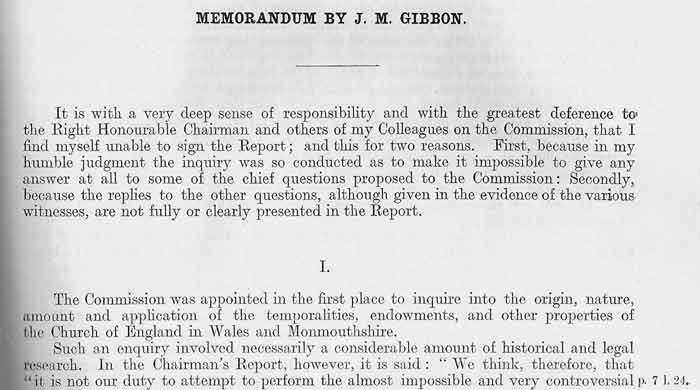www.pillars-of-faith.com |
Pillars Of FaithRemembrance of Nonconformist and other chapels in The Rhondda |

[Whilst most of the Commissioners signed the final Report on 1st November, 1910 , despite some 19 revisions of the Report and over 40 private sittings of the Commission between 28th July, 1908 and 1st November, 1910, (the 1st draft was presented at the sitting of March 9th, 1909) - the Reverend J. Morgan Gibbon felt he was unable to sign it. He gave his reasons in his memorandum which is now copied in full. Whilst this is not specific to the Rhondda (apart from a few brief quotes), it does have value as it paints a quite clear picture of chapel life at that time. The author, a Congregationalist minister, was no doubt in fear that the final Report would sway against the Nonconformist cause for the disestablishment of the Church of England in Wales. He was later to write a book (which I have not read) to state the Nonconformist case.]......Such an enquiry involved necessarily a considerable amount of historical and legal research. In the Chairman's Report, however it is said: 'We think, therefore, that it is not our duty to attempt to perform the almost impossible and very controversial task of ascertaining the historic legal origin of Church property, which includes property of such ancient origin as glebe lands and tithes.' But no such view of the Commission's duty in this respect was put forward during the public sittings. On the contrary witnesses were, from time to time, questioned on these matters. The Chairman said: 'Then I pointed out that with regard to the earlier part of the terms of reference, that this is the part which only relates to the Church of England, we were directed to inquire into the origin, nature, amount and application of the temporalities and endowments and other properties of the Church of England in Wales and Monmouthshire. Of course, it was relevant to that to find out what the origin of these various things was, but we have agreed among ourselves, that instead of calling witnesses we would ask learned gentlemen, to be nominated by ourselves, to give us in writing a history of the origin and act upon that.' It was also intimated from the Chair as late as June 5th, 1908, a few days before the examination of witnesses was brought to a close, that 'men of reputation as historians on the one side and the other,' would be consulted upon the historical and legal questions involved in this reference. But nothing was done or attempted in the matter. The question raised more than once whether ancient buildings and sites, which have come down to the Established Church from former ages, can, in any sense be called a provision made by this church is not alluded to in the Report, much less decided. The Commission limited its labours to the simple secretarial functions of taking down and summarising so much financial and other information as Sir Lewis Dibdin was willing to give. The details, which he declined to disclose even under repeated pressure the Commisssion bade no further effort to get. [Sir Lewis Dibdin - First Church Estates Commissioner of the Ecclesiastical Commission]Thus the evidence heard by the Commission adds but little or nothing to what was previously known respecting the amount of the Church's property, while as to the nature and origin of this property, it is my opinion, by far the most important of all the questions submitted to the Commissioners, the inquiry was shelved altogether; no evidence whatever was heard, and no answer can be given. |
| © COPYRIGHT 2009 ALL RIGHTS RESERVED PILLARS-OF-FAITH.COM |